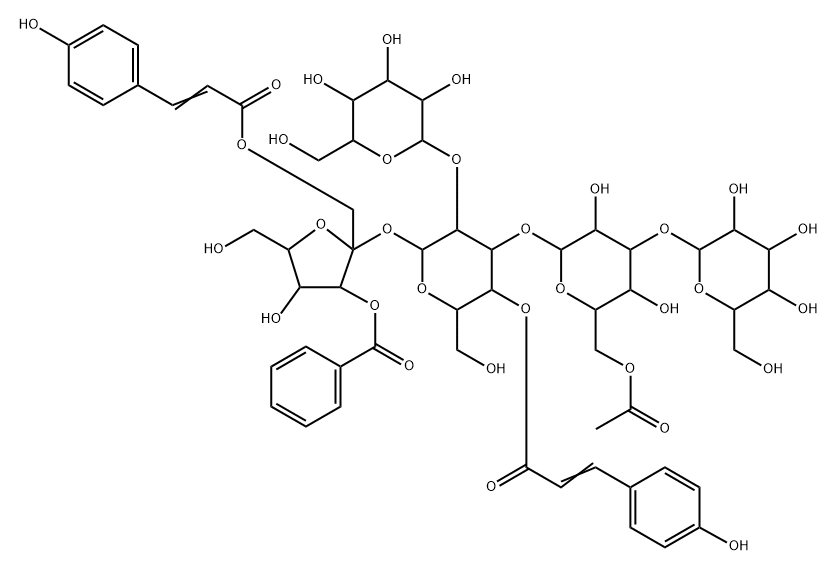Tenuifoliose KCAS# 147742-16-3 |

Quality Control & MSDS
Package In Stock
Number of papers citing our products

| Cas No. | 147742-16-3 | SDF | Download SDF |
| PubChem ID | N/A | Appearance | Powder |
| Formula | C57H70O32 | M.Wt | 1267.27 |
| Type of Compound | N/A | Storage | Desiccate at -20°C |
| Solubility | Soluble in Chloroform,Dichloromethane,Ethyl Acetate,DMSO,Acetone,etc. | ||
| General tips | For obtaining a higher solubility , please warm the tube at 37 ℃ and shake it in the ultrasonic bath for a while.Stock solution can be stored below -20℃ for several months. We recommend that you prepare and use the solution on the same day. However, if the test schedule requires, the stock solutions can be prepared in advance, and the stock solution must be sealed and stored below -20℃. In general, the stock solution can be kept for several months. Before use, we recommend that you leave the vial at room temperature for at least an hour before opening it. |
||
| About Packaging | 1. The packaging of the product may be reversed during transportation, cause the high purity compounds to adhere to the neck or cap of the vial.Take the vail out of its packaging and shake gently until the compounds fall to the bottom of the vial. 2. For liquid products, please centrifuge at 500xg to gather the liquid to the bottom of the vial. 3. Try to avoid loss or contamination during the experiment. |
||
| Shipping Condition | Packaging according to customer requirements(5mg, 10mg, 20mg and more). Ship via FedEx, DHL, UPS, EMS or other couriers with RT, or blue ice upon request. | ||

Tenuifoliose K Dilution Calculator

Tenuifoliose K Molarity Calculator
| 1 mg | 5 mg | 10 mg | 20 mg | 25 mg | |
| 1 mM | 0.7891 mL | 3.9455 mL | 7.891 mL | 15.782 mL | 19.7274 mL |
| 5 mM | 0.1578 mL | 0.7891 mL | 1.5782 mL | 3.1564 mL | 3.9455 mL |
| 10 mM | 0.0789 mL | 0.3945 mL | 0.7891 mL | 1.5782 mL | 1.9727 mL |
| 50 mM | 0.0158 mL | 0.0789 mL | 0.1578 mL | 0.3156 mL | 0.3945 mL |
| 100 mM | 0.0079 mL | 0.0395 mL | 0.0789 mL | 0.1578 mL | 0.1973 mL |
| * Note: If you are in the process of experiment, it's necessary to make the dilution ratios of the samples. The dilution data above is only for reference. Normally, it's can get a better solubility within lower of Concentrations. | |||||

Calcutta University

University of Minnesota

University of Maryland School of Medicine

University of Illinois at Chicago

The Ohio State University

University of Zurich

Harvard University

Colorado State University

Auburn University

Yale University

Worcester Polytechnic Institute

Washington State University

Stanford University

University of Leipzig

Universidade da Beira Interior

The Institute of Cancer Research

Heidelberg University

University of Amsterdam

University of Auckland

TsingHua University

The University of Michigan

Miami University

DRURY University

Jilin University

Fudan University

Wuhan University

Sun Yat-sen University

Universite de Paris

Deemed University

Auckland University

The University of Tokyo

Korea University
- Tenuifoliose J
Catalog No.:BCX2017
CAS No.:147742-14-1
- Tenuifoliose B
Catalog No.:BCX2016
CAS No.:139682-02-3
- Heteroclitin F
Catalog No.:BCX2015
CAS No.:144049-67-2
- Benzoyloxokadsuranol
Catalog No.:BCX2013
CAS No.:130252-47-0
- Ananonin A
Catalog No.:BCX2012
CAS No.:1314021-67-4
- 5,8-Dihydroxy-6,7,3′,4′-tetramethoxyflavone
Catalog No.:BCX2011
CAS No.:683278-67-3
- 2,5-Dihydroxy-7-methoxyflavanone
Catalog No.:BCX2010
CAS No.:35486-66-9
- 17β-Tenacigenin B
Catalog No.:BCX2009
CAS No.:863767-79-7
- (-)-Torreyol
Catalog No.:BCX2008
CAS No.:19435-97-3
- (-)-cis-Calamenene
Catalog No.:BCX2007
CAS No.:483-77-2
- Schiarisanrin D
Catalog No.:BCX2006
CAS No.:188943-88-6
- Paeonicluside
Catalog No.:BCX2005
CAS No.:448231-30-9
- α-Cadinol
Catalog No.:BCX2019
CAS No.:481-34-5
- Tenuifoliose C
Catalog No.:BCX2020
CAS No.:139682-03-4
- Binankadsurin A
Catalog No.:BCX2021
CAS No.:77165-79-8
- Ananonin B
Catalog No.:BCX2022
CAS No.:1314021-69-6
- Catechin 7,3'-di-O-beta-D-glucopyranoside
Catalog No.:BCX2023
CAS No.:105330-53-8
- Lansiumamide B
Catalog No.:BCX2024
CAS No.:121817-37-6
- 5-(alpha-D-galactopyranosyl-(1→6)-alpha-D-galactopyranosyloxymethyl)-2-furancarboxaldehyde
Catalog No.:BCX2025
CAS No.:1454574-91-4
- 5-(alpha-D-galactopyranosyloxymethyl)-2-furancarboxaldehyde
Catalog No.:BCX2026
CAS No.:890652-72-9
- Lansiumamide C
Catalog No.:BCX2027
CAS No.:121817-38-7
- Isorhamnetin-3-O-glucosyl-(1->4)-O-rhamnoside
Catalog No.:BCX2028
CAS No.:1135753-17-1
- 5-[(alpha-D-galactopyranosyloxy)methyl]-1H-pyrrole-2-carbaldehyde
Catalog No.:BCX2029
CAS No.:1377977-55-3
- Multinoside A
Catalog No.:BCX2030
CAS No.:59262-54-3
[UPLC/Q-TOF MS-Based Metabolomics Analysis of Chemical uiterences in Different Polygala tenuifolia Varieties].[Pubmed:26930975]
Zhong Yao Cai. 2015 Sep;38(9):1819-24.
OBJECTIVE: The chemical differences of Polygala tenuifolia varieties-JinYuan 1 (JY1), FenYuan 2 (FY2) and traditional FenYang (FY) were studied, in order to provide reference for the breeding of Polygala tenuifolia. METHODS: The samples of JY1, FY2 and FY were subjected to ultra-high performance liquid chromatography (UPLC) quadrupole time-of-flight mass spectrometry (Q-TOF MS) analysis. The obtained data were analyzed using Principal Component Analysis (PCA) and other statistical analysis methods, and differential metabolites were further figured out. RESULTS: Compared with FY,sucrose esters (such as sibiricoses A5 and tenuifoliside B) and oligosaccharides (such as Tenuifoliose K) in JY1 and FY2 contributed more to the separation of Polygala tenuifolia varieties in the PCA score plot. Compared with JYl, The sugar esters (such as tenuifoliside B and tenuifoliside A) and oligosaccharides( such as tenuifoliose A) in the FY2 also contributed more to the separation of Polygala tenuifolia varieties in the PCA score plot. In addition, the relative contents of sibiricaxanthone A,3,6'-disinapoly sucrose and senegin III showed significant differences among FY, JY1 and FY2. CONCLUSION: As new Polygala tenuifolia varieties, JY1 and FY2 had certain differences and respective advantages on the chemical composition compared with FY,which could provide data support for the directional breeding of Polygala tenuifolia based on the contents of some active compounds.


